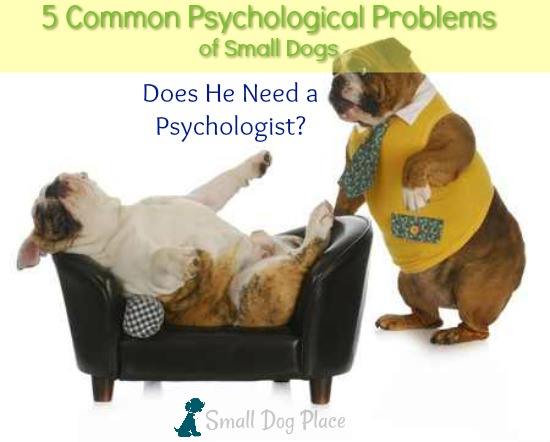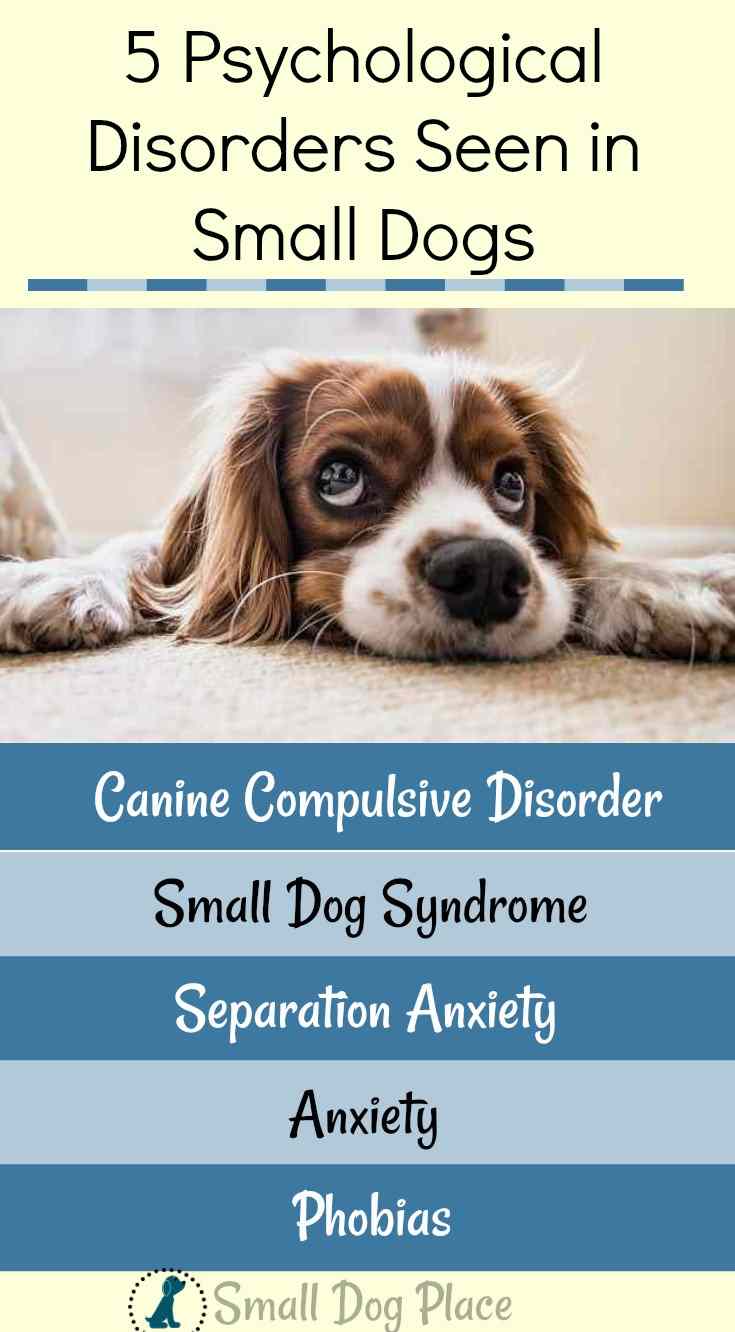Common Mental Disorders in Small Dogs
Mental Disorders in Small Dogs or Just Problem Behaviors?
by James Shore |Last updated January 30, 2020
Mental Disorders in small dogs seem to occur more frequently than in mid-size to large breed dogs. Why does this happen.
Table of Contents for Mental Disorders in Small Dogs
Causes of Psychological Troubles in Dogs
Common Psychological Disorders in Dogs
The difference in sizes, shapes, face features and breeds impact the canine psychology. Besides genetic variation, environment and dog owners themselves have an impact on shaping the psychology of dogs and, therefore, canine behavior.
What Are The Causes Of Psychological Troubles in Dogs?
At the University of Sydney, a research team led by Paul
McGreevy investigated the issue, and the results were published in PLoS One in 20131.
They studied the correlation between head
and body shape with psychological behaviors.
Considering the two types of dog skull shapes, ‘dolichocephalic’ (narrow head and long snout) and ‘brachiocephalic’ (broad head and short snout), dogs are selectively bred to develop cute facial features and excellent hunting skills respectively. Selective breeding affects the skull shape and the organization of canine brain2.
Head and body shape research sheds light on mental disorders in small dogs
To accomplish this research, Paul McGreevy utilized the C-BARQ (Canine Behavioral Assessment and Research Questionnaire) survey that was maintained by University of Pennsylvania.
He wanted to understand the correlation between body shape and behavior. His findings show that the smaller the dog size, the more psychological or behavioral problems will emerge.
Short breeds (Height), for example will beg for food, suffer from separation anxiety, have attention issues, urinate around the house when left alone, be over-sensitive, roll in feces, and fear big dogs. They are hard to train due to stubborn behavior traits.
A dog's weight also plays a role according to this research. It would seem that the lighter the breed is in weight, the more hyperactive, attention-seeking, and dominating they are with a show of “dog-rivalry.”
Dolichocephalic were mostly found to be fearful of strangers. Brachiocephalic were noticed as brave and aggressive attackers. The researchers concluded their results as: “Generally, undesirable behaviors become more common or pronounced as height and weight decrease.”
Does this mean that all small dogs will eventually develop mental disorders? While genetics is a factor that we do not have complete control over, the story is different if we look at small dog owners and the dog's environment.
We as dog parents have the most control over whether our dog will become a behavior problem or develop a psychological disorder.
The following mental disorders in small dogs will not necessarily affect your dog. Pay close attention to the Cause section of each disorder and see if there are ways you can alter the way you respond to your fur baby. It will be worth it in the end.
What are the Most Common Mental Disorders in Small Dogs?
Depression

Depression, is it real? It is sad to think our four-legged family members may be depressed. They provide us with so much love and companionship, and we want only the best for their well-being.
Our canine relationships have deepened to where dogs who were once relegated to the dog house outside now shares our home, our time and even our bed.
Canine Compulsive Disorder (CCD)
Small breeds can suffer from compulsive behaviors because they have attention problems. If dogs are ignored after being spoiled with lots of care at the puppy stage, they will indulge in behaviors like tail-chasing, excessive licking, etc.
Research by Bridget Waller shows that people like to select dogs based on the childish features, (paeodmorphism)3. Such selection leads to the spoiling of the dogs to an excessive level.
Causes
Unfortunately, small breeds are spoiled to a great extent by excessive love and care. When they are left alone, they find it difficult to cope up the stress. Sometimes, CCD develops due to lack of exercise, especially in highly active breeds that need a fair amount of exercise.
As in humans, CCD develops in dogs as a way to overcome stress and anxiety. These issues can occur due to several reasons. For example, the change of environment, routine or behavior of the owner, boredom, lack of activity or confinement for long hours are stressful for dogs and will bring on the symptoms.
Symptoms
Canine compulsive disorder (CCD) is identified with repetitive actions or behaviors. The significant activities that characterize CCD are shadow-chase, tail-chase, excessive licking, flank-sucking, and snapping at flies or butterflies.
Treatment
First, you have to identify the reasons behind CCD that's developing in your dog. Then, eliminate all kinds of stress, boredom, and other relevant causes to see the change. If it doesn’t work, ask for professional help. Human drugs like anti-anxiety and serotonergic drugs are effective in reducing CCD in dogs. This is a group of drugs that inhibit serotonin re-uptake and includes antidepressant.
Besides medication, train the dog via positive reinforcement to develop healthy behaviors.
Read more about Compulsive Disorder in Dogs
Related: Can Dogs Have OCD Symptoms
Small Dog Syndrome
Small dog syndrome is a collective name for a range of actions showed by small dogs. They are caused due to the smallness of size.
Causes
Small dog syndrome is often promoted in small dogs by dog owners themselves through positive reinforcement. Many dog owners do not train their dogs well and support the development of negative behavior. This leads to lack of obedience and stubborn behavior.
Would you still complain about your dog’s behavior if you knew you were somewhat at fault?
Symptoms
Dogs will show most of these behaviors when they are suffering from small dog syndrome:
- Jumping up on people or stray dogs,
- Snapping at assumed threats,
- Fear of large dogs,
- Growling and barking at other dogs or people,
- Lack of obedience,
- Excited behavior, and
- Resistance to moving from beds and couches.
If the dog shows one or two of these responses, then he may not be suffering from SDS.
Treatment
Counter-conditioning works well to treat SDS. Just stay consistent in your behavior. Let your dog play with large breed dogs and move around strangers in a usual routine.
Remove the barriers of fear from his mind. If he is anti-social, socialize him with other small dogs. Let him play with friendly large breed dogs that are well-socialized already.
You just have to play with his psychology through positive motivations. In extreme cases, you can take the help of an animal behaviorist and a good dog trainer.
Learn more about Small Dog Syndrome
Separation Anxiety
Separation Anxiety is common among hyperactive dog breeds regardless of the size they are. But, mostly dog owners spoil their cute-faced small dogs with their love and attention, which has behavioral repercussions. Separation anxiety is one of them.
Causes
Small dogs are usually given so much attention that they get used to walking in the limelight. When the owners detach from their dogs for even a few hours, they feel abandoned and ignored. As an expression of their feelings, they yelp, bark or cry.
Small dogs that are not trained to endure separation and play on their own are prone to suffer from separation anxiety.
Symptoms
Separation anxiety is characterized by many symptoms, including yelping, loud crying, barking, destructiveness, hiding, anorexia, panting, and house soiling.
Treatment
Little furballs often consider the separation to be an eternal one. You have to give confidence to your pooch that you will return soon every day. Besides this, you have to avoid showing affection before leaving the house. Make him understand some cues of separation: picking the car keys, wearing uniforms, etc. Practice with the dog short periods of separation.
Counter-conditioning is another training method in which you have to discourage the unwanted behavior and teach him new and better responses. You can leave a hidden treat for your dog before departing to keep him engaged and happy.
Regarding medications, stress, anxiety, and depression can be cured by giving the dogs a dose of melatonin. It is recommended that you consult the vet before giving your dog any medication.
Learn more about Separation Anxiety
Anxiety in Small Dogs
Small dogs can often feel nervous and anxious in certain situations. Besides separation anxiety, small dogs can be anxious due to a lot of different reasons.
Causes
Dogs can suffer from anxiety due to the unpredictability of situation, long-term absence of the owner, and loud horrifying noises in strange places. Anxiety is associated with various symptoms that are evident in dog behavior.
Symptoms
The symptoms indicative of anxiety are nervous peeing around the house, panting accompanied by drooling, extreme shivering, belly crouching (also called pancaking), and snapping at possible threats.
Treatment
You have to adopt ‘calm down and get rewarded’ approach, where you let the dog calm down before you give him a treat. It’s better not to cuddle him up when he is panicking on the floor because it will reinforce the behavior in attention-seeking dogs.
If the dog is peeing around the house due to anxiety, shouting at him wouldn’t help. Your aggression will shy him away into more fear. For aggressive snaps, you will have to command him with a firm “No" consistently. There are some medications like Dramamine and Valium that are used to tone down anxiety in dogs.
Related: General Anxiety in Dogs
Using Music to Calm an Anxious Dog
Phobias / Fears
Small dogs, due to their short stature, are fearful of loud noises, big dogs, and strangers. Although some miniature dogs show a dominating attitude to large breed dogs, they still have a small heart to face any trouble.
Causes
If you have set out for an adventure in the wild, strange noises and unknown animals can threaten or injure your dog. Such experiences can inculcate fear in your dog.
Sometimes, the owner’s reaction to the dog, when he first develops the phobia, is encouraging. In some cases, the negative experience of the past can act as a stimulus for fearful behavior. For example, if the previous dog owner used to shout in aggression, the dog can associate any behavior close to it as threatening.
Symptoms
There are different kinds of phobias dog may have or develop through time, including water, heights, stray dogs, big dogs, noises from the vacuum cleaner, etc.
Symptoms of fear are evident when you notice:
- Shivering
- Panting
- Drooling
- Eliminating
- Escaping the situation.
Other indications include aggression, loss of appetite, and inactivity.
Treatment
Treatments are based on the
phobia a dog has, its fear-eliciting stimuli, and the kind of response.
Counter-conditioning can be a useful method to curb fears and phobias. One of
the techniques called ‘flooding’ can be used that involves exposure of the dog
to fear-eliciting stimuli for a long time.
The dogs can get habituated to such conditions, and the fearful responses are toned down. However, ‘flooding’ is not suitable for dogs of all ages, specifically the adult dogs. The severity of the problem can be treated by using anxiolytic drugs (anti-anxiety drugs such as tranquilizers, to aid the behavior modification program.
Related: Fear of Thunderstorms
Dealing with Stress in Small Dogs
Stress in small dog breeds. We all know what stress looks like in people but how does stress in dogs appear?
Everyone experiences stress from time to time, and some of us experience more frequently than others. In people, symptoms of stress can fall into four main categories.
Read about Stress in Small Dogs
Conclusion
In any of the psychological or behavioral issues, you have to employ the method of ‘good training.’ Around 60-70 % of the small dog owners play a role in promoting these unwanted behaviors. If you have a small dog, replay in your mind the positive reactions you gave to your dog during critical situation; and it will help you identify the cause quite quickly.
References - Mental Disorders in Small Dogs
1http://journals.plos.org/plosone/article?id=10.1371/journal.pone.0080529#pone-0080529-g00
2http://journals.plos.org/plosone/article?id=10.1371/journal.pone.0011946
3http://journals.plos.org/plosone/article?id=10.1371/journal.pone.0082686
Author Bio
James Shore is the author of this article, "5 Mental Disorders in Small Dogs."

James Shore is a part-time dog-trainer and dog behavior consultant. He is a professional freelancer with years of experience in dog training. He is interested in finding out fun ways to handle dog behaviors, specifically, Labradors to help dog-owners enjoy their companions at all times. His pet-passion led him to develop Labrador Training HQ to help people.
About Janice (author and voice behind this site)
Janice Jones has lived with dogs and cats for most of her life and worked as a veterinary technician for over a decade. She has also been a small-breed dog breeder and rescue advocate and holds academic training in psychology, biology, nursing, and mental health counseling. Her work focuses on helping dog owners make informed, responsible decisions rooted in experience, education, and compassion.
When not writing, reading, or researching dog-related topics, she likes to spend time with her six Shih Tzu dogs, her husband, and her family, as well as knitting and crocheting. She is also the voice behind Miracle Shih Tzu and Smart-Knit-Crocheting
Does This Article Deserve Your Thumbs Up?
We always appreciate your support and encouragement. Your thumbs up means so much to us. Please like this article.
If you find this page or any page on Small Dog Place Helpful, or useful in anyway, I'd love it if you would click the small heart found on the bottom right of each page.
You can also share or bookmark this page -- just click on the:

Free Monthly Newsletter
Sign Up for Our Free Newsletter and get our Free Gift to You.
my E-book, The Top 10 Mistakes People Make When Choosing a Dog (and how to avoid them)



